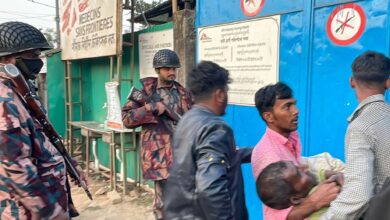
As clashes between local resistance fighters and regime forces resume along the Chindwin River in Sagaing Region’s Kani Township, the number of displaced locals continues to rise.
Shootouts that initially broke out in the region in early April have escalated since Saturday, forcing more than 15,000 locals from 40 villages to flee their homes, according to a leader of the Kani Township Protest Committee.
“Everyone is on the run because they heard the junta’s troops are coming and they’re worried their villages will be raided,” he said, noting that many villages along the eastern bank of the Chindwin River have already been targeted.
“They’re on the run for their safety. Day and night, they have to move once they start hearing something unusual,” he added.
Many residents of the area have taken shelter with relatives in villages outside the conflict zone, while others have had to hide in the forest, according to local sources.
On May 6, a clash took place near Kin, a village on the Chindwin River. An increased military presence in the area since then has forced more than a thousand families to flee.
Displaced people from the village said they have had to repeatedly flee their temporary shelters as fighting has become more frequent along the river.
“We can’t sleep well at night. No one can,” a Kin villager told Myanmar Now by telephone.
Young children and the elderly are among the displaced and in need of food and medical assistance as the rainy season approaches, according to volunteers involved in the relief effort.
In early April, clashes between the military and local resistance fighters broke out along the Monywa-Yar Gyi-Kalaywa road in Kani. The fighting spread to villages along the Chindwin River in early May.
Last Saturday, military trucks passing near Hmyaing, a village on the Kani-Mingin road, were hit by explosives. There were many casualties in the attack, but the exact number could not be confirmed, according to members of a local defence team.
On Tuesday, there was a clash near Letpansu, a village on the east bank of the Chindwin, and the military occupied Htupauk, a neighbouring village in Kani Township.
Later on, the military raided other villages in the area, such as Kyawmakyar, Wayar and Kywetet, and looted valuable items from locals, including motorcycles.
On Thursday morning, regime troops raided the villages of Kyawywar, Zeehpyukone and Shanmyaung in Kani Township, taking food and other property left behind by fleeing residents.
From May 22 to 27, there were three clashes between regime forces and local resistance forces in Kani Township, killing at least nine local members and injuring 20, mainly from shelling, according to a member of the local defence force.
Anti-dictatorship protests were widespread in Kani before the current conflict began. Defence groups armed with hunting rifles and homemade weapons began forming in early April to protect civilians from the military’s violent crackdowns.



